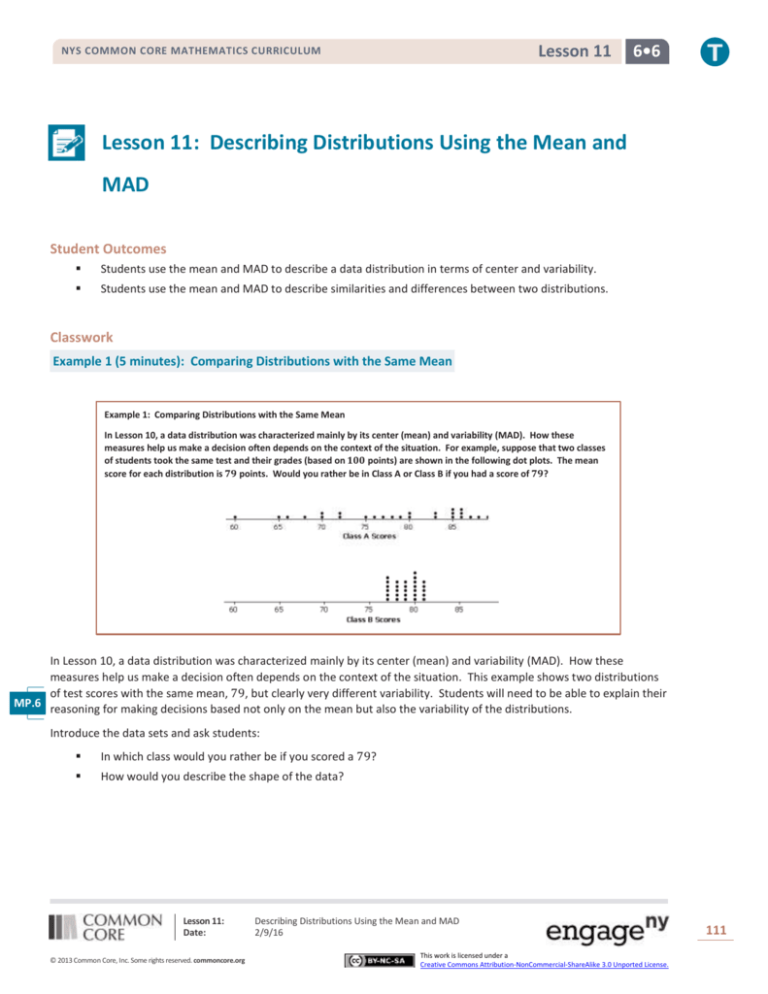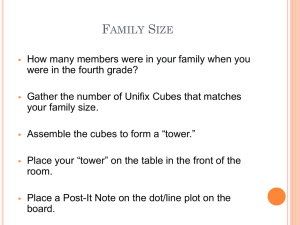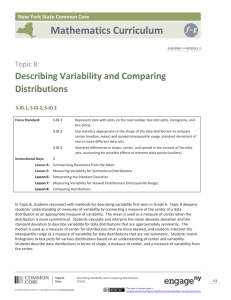
Lesson 11
NYS COMMON CORE MATHEMATICS CURRICULUM
6•6
Lesson 11: Describing Distributions Using the Mean and
MAD
Student Outcomes
Students use the mean and MAD to describe a data distribution in terms of center and variability.
Students use the mean and MAD to describe similarities and differences between two distributions.
Classwork
Example 1 (5 minutes): Comparing Distributions with the Same Mean
Example 1: Comparing Distributions with the Same Mean
In Lesson 10, a data distribution was characterized mainly by its center (mean) and variability (MAD). How these
measures help us make a decision often depends on the context of the situation. For example, suppose that two classes
of students took the same test and their grades (based on 𝟏𝟎𝟎 points) are shown in the following dot plots. The mean
score for each distribution is 𝟕𝟗 points. Would you rather be in Class A or Class B if you had a score of 𝟕𝟗?
In Lesson 10, a data distribution was characterized mainly by its center (mean) and variability (MAD). How these
measures help us make a decision often depends on the context of the situation. This example shows two distributions
of test scores with the same mean, 79, but clearly very different variability. Students will need to be able to explain their
MP.6
reasoning for making decisions based not only on the mean but also the variability of the distributions.
Introduce the data sets and ask students:
In which class would you rather be if you scored a 79?
How would you describe the shape of the data?
Lesson 11:
Date:
© 2013 Common Core, Inc. Some rights reserved. commoncore.org
Describing Distributions Using the Mean and MAD
2/9/16
This work is licensed under a
Creative Commons Attribution-NonCommercial-ShareAlike 3.0 Unported License.
111
Lesson 11
NYS COMMON CORE MATHEMATICS CURRICULUM
6•6
Exercises 1–3 (5–7 minutes)
Let students work independently. Then discuss and confirm answers as a class.
Exercises 1–6
1.
Looking at the dot plots, which class has the greater MAD? Explain without actually calculating the MAD.
Class A. The data for Class A has a much wider spread. Thus, it has greater variability and a larger MAD.
2.
If Liz had one of the highest scores in her class, in which class would she rather be? Explain your reasoning.
She would rather be in Class A. This class had higher scores in the 𝟗𝟎s, whereas Class B had a high score of only 𝟖𝟏.
3.
If Logan scored below average, in which class would he rather be? Explain your reasoning.
Logan would rather be in Class B. The low scores in B were in the 𝟕𝟎s, whereas Class A had low scores in the 𝟔𝟎s.
Exercises 4–6 (10–12 minutes)
Let students work in pairs. Discuss answers to Exercises 5–6 as a class.
Exercises 4–6
Your little brother asks you to replace the battery in his favorite remote control car. The car is constructed so that it is
difficult to replace its battery. Your research of the lifetimes (in hours) of two different battery brands (A and B) shows
the following data for 𝟐𝟎 batteries from each brand:
A
B
𝟏𝟐
𝟏𝟖
𝟏𝟒
𝟏𝟖
𝟏𝟒
𝟏𝟗
𝟏𝟓
𝟏𝟗
𝟏𝟔
𝟏𝟗
𝟏𝟕
𝟏𝟗
𝟏𝟕
𝟏𝟗
𝟏𝟖
𝟏𝟗
𝟏𝟗
𝟐𝟎
𝟐𝟎
𝟐𝟎
𝟐𝟏
𝟐𝟎
𝟐𝟏
𝟐𝟎
𝟐𝟑
𝟐𝟎
𝟐𝟑
𝟐𝟏
𝟐𝟒
𝟐𝟏
4.
To help you decide which battery to purchase, start by drawing a dot plot for each brand.
5.
Find the mean battery life for each brand and compare them.
𝟐𝟒
𝟐𝟏
𝟐𝟒
𝟐𝟏
𝟐𝟓
𝟐𝟐
𝟐𝟔
𝟐𝟐
𝟐𝟕
𝟐𝟐
The mean of Brand A is 𝟐𝟎 hours.
The mean of Brand B is 𝟐𝟎 hours.
Lesson 11:
Date:
© 2013 Common Core, Inc. Some rights reserved. commoncore.org
Describing Distributions Using the Mean and MAD
2/9/16
This work is licensed under a
Creative Commons Attribution-NonCommercial-ShareAlike 3.0 Unported License.
112
Lesson 11
NYS COMMON CORE MATHEMATICS CURRICULUM
6.
6•6
Looking at the variability of each data set shown in its dot plot, give one reason you would choose Brand A. What is
one reason you would choose Brand B? Explain your reasoning.
Answers will vary.
Brand A: take a risk and hope the battery lasts longer. You may get a good, long-lasting battery.
Brand B: the battery range is around 𝟐𝟎 hours. Most of the batteries in this brand last that long.
Example 2 (5–7 minutes): Comparing Distributions with Different Means
Example 2: Comparing Distributions with Different Means
You have been comparing distributions that have the same mean, but different variability. As you have seen, deciding
whether large variability or small variability is best depends on the context and on what is being asked. For example, in
Exercise 2, Liz preferred to be in the distribution with more variability because she had one of the highest scores in the
class. Thus, her score would have been higher had she been in Class A than had she been in Class B. Logan, on the other
hand, preferred the class with lesser variability (i.e., Class B), since his score was below average.
If two data distributions have different means, how does a measure of variability play a part in making decisions?
Recount the pairs of distributions from Example 1 and Exercises 1–6 that had the same means and how variability played
a role in making decisions.
Then answer the question posed in the text: If two data distributions have different means, how does a measure of
MP.2 variability play a part in making decisions?
Comparing the variability in distributions with different means is not really any different, as variability is not
concerned with location.
Note that when the magnitude of the data sets is substantially different, it may not be possible to graph both
sets using the same scaling. In such cases, students should be careful in drawing a conclusion concerning
variability because what may appear to be differing amounts of spread may not be that different at all.
Encourage your students to draw dot plots using a scale that covers the span of both distributions whenever
possible.
If the magnitude of the two distributions is substantially different so that using the same scale is not practical,
then advise them to be very careful comparing variability visually. That case requires the use of a measure,
such as the MAD.
Lesson 11:
Date:
© 2013 Common Core, Inc. Some rights reserved. commoncore.org
Describing Distributions Using the Mean and MAD
2/9/16
This work is licensed under a
Creative Commons Attribution-NonCommercial-ShareAlike 3.0 Unported License.
113
Lesson 11
NYS COMMON CORE MATHEMATICS CURRICULUM
6•6
Exercises 7–9 (10–12 minutes)
Let students continue to work in pairs to complete Exercises 7–9. Then confirm answers to Exercises 8 and 9 as a class.
Calculators are needed for this exercise.
Exercises 7–9
Suppose that you wanted to answer the following question: Are field crickets better predictors of atmospheric
temperature than katydids are? Both species of insect make chirping sounds by rubbing their front wings together.
The following data are the number of chirps (per minute) for 𝟏𝟎 insects each. All the data were taken on the same
evening at the same time.
Insect
Crickets
Katydids
7.
𝟏
𝟑𝟓
𝟔𝟔
𝟐
𝟑𝟐
𝟔𝟐
𝟑
𝟑𝟓
𝟔𝟏
𝟒
𝟑𝟕
𝟔𝟒
𝟓
𝟑𝟒
𝟔𝟑
𝟔
𝟑𝟒
𝟔𝟐
𝟕
𝟑𝟖
𝟔𝟖
𝟖
𝟑𝟓
𝟔𝟒
𝟗
𝟑𝟔
𝟔𝟔
𝟏𝟎
𝟑𝟒
𝟔𝟒
Draw dot plots for these two data distributions using the same scale, going from 𝟑𝟎 to 𝟕𝟎. Visually, what
conclusions can you draw from the dot plots?
Visually you can see a higher value for the mean of the katydids. The variability looks to be similar.
8.
Calculate the mean and MAD for each distribution.
Crickets: The mean is 𝟑𝟓 chirps per minute.
The MAD is 𝟏. 𝟐 chirps per minute.
Katydids: The mean is 𝟔𝟒 chirps per minute.
The MAD is 𝟏. 𝟔 chirps per minute.
9.
The outside temperature 𝑻 can be predicted by counting the number of chirps made by these insects.
a.
For crickets, 𝑻 is found by adding 𝟒𝟎 to its mean number of chirps per minute. What value of 𝑻 is being
predicted by the crickets?
The predicted temperature is 𝟑𝟓 + 𝟒𝟎 or 𝟕𝟓 degrees.
b.
For katydids, 𝑻 is found by adding 𝟏𝟔𝟏 to its mean number of chirps per minute and then dividing the sum by
𝟑. What value of 𝑻 is being predicted by the katydids?
The predicted temperature is
Lesson 11:
Date:
© 2013 Common Core, Inc. Some rights reserved. commoncore.org
(𝟔𝟒+𝟏𝟔𝟏)
𝟑
or 𝟕𝟓 degrees.
Describing Distributions Using the Mean and MAD
2/9/16
This work is licensed under a
Creative Commons Attribution-NonCommercial-ShareAlike 3.0 Unported License.
114
Lesson 11
NYS COMMON CORE MATHEMATICS CURRICULUM
c.
6•6
The temperature was 𝟕𝟓 degrees when these data were recorded, so using the mean from each data set gave
an accurate prediction of temperature. If you were going to use the number of chirps from a single cricket or
a single katydid to predict the temperature, would you use a cricket or a katydid? Explain how variability in
the distributions of number of chirps played a role in your decision.
The crickets had a smaller MAD. This indicates that an individual cricket is more likely to have a number of
chirps that is close to the mean.
Lesson Summary
This lesson focused on comparing two data distributions based on center and variability. It is important to consider
the context when comparing distributions. In decision-making, drawing dot plots and calculating means and MADs
can help you make informed decisions.
Exit Ticket (5 minutes)
Lesson 11:
Date:
© 2013 Common Core, Inc. Some rights reserved. commoncore.org
Describing Distributions Using the Mean and MAD
2/9/16
This work is licensed under a
Creative Commons Attribution-NonCommercial-ShareAlike 3.0 Unported License.
115
Lesson 11
NYS COMMON CORE MATHEMATICS CURRICULUM
Name ___________________________________________________
6•6
Date____________________
Lesson 11: Describing Distributions Using the Mean and MAD
Exit Ticket
You need to decide which of two brands of chocolate chip cookies to buy. You really love chocolate chip cookies. The
numbers of chocolate chips in each of five cookies from each brand are as follows:
Cookie
ChocFull
AllChoc
1
17
22
2
19
15
3
18
14
4
18
21
5
18
18
a.
Draw a dot plot for each set of data that shows the distribution of number of chips for each brand. Use a scale for
your dot plots that covers the same span for both distributions.
b.
Find the mean number of chocolate chips for each of the two brands. Compare the means.
c.
Looking at your dot plots and considering variability, which brand do you prefer? Explain your reasoning.
Lesson 11:
Date:
© 2013 Common Core, Inc. Some rights reserved. commoncore.org
Describing Distributions Using the Mean and MAD
2/9/16
This work is licensed under a
Creative Commons Attribution-NonCommercial-ShareAlike 3.0 Unported License.
116
Lesson 11
NYS COMMON CORE MATHEMATICS CURRICULUM
6•6
Exit Ticket Sample Solutions
You need to decide which of two brands of chocolate chip cookies to buy. You really love chocolate chip cookies. The
numbers of chocolate chips in each of five cookies from each brand are as follows:
Cookie
ChocFull
AllChoc
𝟏
𝟏𝟕
𝟐𝟐
𝟐
𝟏𝟗
𝟏𝟓
𝟑
𝟏𝟖
𝟏𝟒
𝟒
𝟏𝟖
𝟐𝟏
𝟓
𝟏𝟖
𝟏𝟖
a.
Draw a dot plot for each set of data that shows the distribution of number of chips for each brand. Use a scale for
your dot plots that cover the same span for both distributions.
b.
Find the mean number of chocolate chips for each of the two brands. Compare the means.
Students should look at both graphs and immediately determine that the means are both 𝟏𝟖 chips, since the
distributions are symmetric around 𝟏𝟖.
c.
Looking at your dot plots and considering variability, which brand do you prefer? Explain your reasoning.
Students could argue either way:
Students who prefer ChocFull may argue that they are assured of getting 𝟏𝟖 chips most of the time, with no
fewer than 𝟏𝟕 chips, and a bonus once in a while of 𝟏𝟗 chips. With AllChoc, they may sometimes get more
than 𝟐𝟎 chips, but would sometimes get only 𝟏𝟒 or 𝟏𝟓 chips.
Students who prefer AllChoc are the risk-takers who are willing to tolerate getting only 𝟏𝟒 or 𝟏𝟓 chips for the
chance of getting 𝟐𝟏 or 𝟐𝟐 chips.
Problem Set Sample Solutions
1.
Two classes took the same mathematics test. Summary measures for the two classes are as follows:
Class A
Class B
a.
Mean
𝟕𝟖
𝟕𝟖
MAD
𝟐
𝟏𝟎
Suppose that you received the highest score in your class. Would your score have been higher if you were in
Class A or Class B? Explain your reasoning.
Class B, because the means are the same. And the variability, as measured by the MAD, is higher in that class
than it is in Class A.
Lesson 11:
Date:
© 2013 Common Core, Inc. Some rights reserved. commoncore.org
Describing Distributions Using the Mean and MAD
2/9/16
This work is licensed under a
Creative Commons Attribution-NonCommercial-ShareAlike 3.0 Unported License.
117
Lesson 11
NYS COMMON CORE MATHEMATICS CURRICULUM
b.
6•6
Suppose that your score was below the mean score. In which class would you prefer to have been? Explain
your reasoning.
Class A because the variability, as measured by the MAD, indicates a more compact distribution around the
mean. Whereas, a score below the mean in Class B could be far lower than in Class A.
2.
Eight tomato plants each of two varieties, LoveEm and Wonderful, are grown under the same conditions. The
numbers of tomatoes produced from each plant of each variety are shown:
Plant
LoveEm
Wonderful
𝟏
𝟐𝟕
𝟑𝟏
𝟐
𝟐𝟗
𝟐𝟎
𝟑
𝟐𝟕
𝟐𝟓
𝟒
𝟐𝟖
𝟓𝟎
𝟓
𝟑𝟏
𝟑𝟐
𝟔
𝟐𝟕
𝟐𝟓
𝟕
𝟐𝟖
𝟐𝟐
𝟖
𝟐𝟕
𝟓𝟏
a.
Draw dot plots to help you decide which variety is more productive.
b.
Calculate the mean number of tomatoes produced for each variety. Which one produces more tomatoes on
average?
Guessing a mean, and checking by summing deviations, is not as obvious for these distributions. So, using the
formula is probably more efficient. The mean number of LoveEm tomatoes is 𝟐𝟖, and the mean number of
Wonderful tomatoes is 𝟑𝟐.
c.
If you want to be able to accurately predict the number of tomatoes a plant is going to produce, which variety
should you choose – the one with the smaller MAD, or the one with the larger MAD? Explain your reasoning.
LoveEm produces fewer tomatoes on average but is far more consistent. Looking at the dot plots, its
variability is far less than that of Wonderful tomatoes. Based on these data sets, choosing LoveEm should
yield numbers in the high 𝟐𝟎s consistently, but the number from Wonderful could vary wildly from lower
yields in the low 𝟐𝟎s, to huge yields around 𝟓𝟎.
d.
Calculate the MAD of each plant variety.
The MAD for LoveEm is 𝟏 tomato.
The MAD for Wonderful is 𝟗. 𝟐𝟓 tomatoes.
Lesson 11:
Date:
© 2013 Common Core, Inc. Some rights reserved. commoncore.org
Describing Distributions Using the Mean and MAD
2/9/16
This work is licensed under a
Creative Commons Attribution-NonCommercial-ShareAlike 3.0 Unported License.
118










